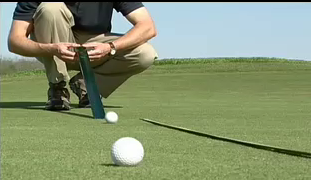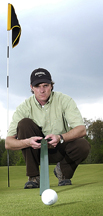
| VIDEO |
 * Cale Bigelow, assistant professor of agronomy, talks about grass varieties used on Midwest golf courses and how the turf affects play. (6 minutes, 7 seconds) * Cale Bigelow, assistant professor of agronomy, talks about grass varieties used on Midwest golf courses and how the turf affects play. (6 minutes, 7 seconds) |
| RELATED INFO |
| * Purdue Department of Agronomy |
| * Purdue Turfgrass Program |
| * Journal of Natural Resources And Life Science Education |

June 7, 2007
Putting green speed is all in grass management
WEST LAFAYETTE, Ind. - |
Turf grass researchers and golf course management experts have ways of influencing how difficult a green is to play, said Cale Bigelow, a Purdue University agronomist and turf expert. The type of grass and management programs can determine whether the velvety looking greens are fast or slow. On fast greens, a slight tap of the putter sends the ball many feet, while a ball struck the same way on a slow green will travel only inches.
To meet specific needs of both professional golfers and weekend duffers on the United States' 16,000 courses, turf scientists have developed and bred new species and varieties of grasses, he said. The various grasses, such as Bermuda, fescue, bentgrass and Kentucky, fill niches on golf courses since different conditions are required depending on the level of play and whether the turf is in the rough, on the fairway or on the green. Climate and soil conditions also play a role in the type of grass used.
Bigelow and groups of high school and college students evaluated various turf management techniques and bentgrass varieties to learn ways golf course managers achieve optimum results to create the desired playing conditions. The Journal of Natural Resources Life Science Education is publishing a paper by Bigelow and turf grass graduate student Kristina Walker about their research. The study explains important golf course management considerations and is a template to teach an important topic in turf management – putting green maintenance.
"I wanted to show that there are other ways besides lowering the mower height to achieve some of the functional characteristics course managers strive for," Bigelow said. "A lot of emphasis is put on maintaining golf greens not only for aesthetic appearance but also for functional quality, such as surface firmness and smoothness. It's a lot more complex than just cutting and watering the grass."
Bigelow and his students evaluated differences in grass types and six management practices using one practice putting green and a research area planted in three bentgrass varieties that differed in leaf texture, color, shoot density and toleration of close-crop, frequent mowing. The researchers subjected the grasses to two mower types, two mowing frequencies, and to using or not using a water-filled roller to firm the surface.
The paper has a summary of ball roll distances the students measured on the three bentgrass varieties depending on a combination of different management practices. For instance, a bentgrass variety called Penncross that was double cut with a walk mower resulted in a much faster green than the same grass single cut with a riding triplex mower. The respective ball roll distances were 10.1 feet and 8.7 feet.
On greens, whether they are fast or slow, players and golf course managers want a hit ball to roll smoothly.
"When you're talking about putting greens and putting green speeds, you want as little friction as possible," Bigelow said. "The primary grass species we use on putting greens is creeping bentgrass because it has a very fine leaf texture. Those smaller, finer leaves offer less resistance to the golf ball as it travels across the surface of the putting green."
In far southern states where climate necessitates the use of hybrid Bermuda grasses, course managers try to keep the grass leaves as upright as possible, Bigelow said. Since those grass varieties are stiff, the ball travels over just the tips, which lessens the friction between the ball and the plant.
Scientists are creating grasses that are more upright, have deeper root systems and are more resistant to pests, diseases and stressful environmental conditions, he said. This helps sustain the turf, but grass still must be kept a certain height.
At most golf courses, greens are mowed almost daily throughout the growing season, he said. On courses where professional golfers play tournaments, however, greens often are mowed several times a day, and watering and fertilizing are strictly controlled. This makes the greens very firm so balls roll faster and farther compared to the conditions encountered by golfers at most golf courses.
"Depending on what you're trying to achieve - fast or slow ball roll - there are ways to achieve that," he said. "Some of those management practices are healthier for the turf than others."
One trend in putting green management is a dramatic decrease over the past two decades in the cutting height on greens, Bigelow said. Twenty years ago the mowing height was about five thirty-seconds inch; five years ago it was about one-eighth inch. Now the common mowing height has shrunk to almost one-tenth inch.
"When you remove that amount of leaf surface area, you're removing the food production part of the turf grass plant," he said. "We're having more and more reports from golf course managers of environmental stress problems on their putting greens. Part of that is probably due to decreased mowing heights.
"If you have less leaf surface area, then you have less photosynthesis, less plant nourishment and sometimes much shallower roots. If you have dry periods or excessive traffic, the plant can't recover because it doesn't have enough carbohydrates in it."
Photosynthesis is the process in which plants use sunlight, carbon dioxide and hydrogen to produce simple carbohydrates, which are compounds plants need to live, grow and reproduce.
The golfing industry wants people to be excited about the sport and to participate, Bigelow said. But people should not expect the courses they play on to be like Augusta National Golf Club, home of the Masters Tournament.
"The condition of those putting greens prepared for golf championships is not something that someone with a 20 handicap should be playing regularly," he said. "If you have really fast putting greens, an amateur will take multiple putts to reach the hole, inevitably increasing frustration and lengthening the time to play a round.
"Whereas, if more reasonable putting green speeds are maintained, people tend to get the ball into the hole more quickly, enjoy the game more and generally have an overall more positive feeling about the sport."
In addition, courses that are consistently kept in championship condition cost substantially more to maintain because of more frequent mowing, reseeding, irrigation and other factors, Bigelow said. This can dramatically increase the cost of playing at those facilities and make them less accessible to the general public.
"The important thing at most courses is to try to make it as much fun as possible for more people to play golf," he said. "Golf is a great opportunity to get some exercise if you don't use the riding cart. This sport is a chance to get outside and enjoy the environment with friends and family instead of sitting in front of the computer or TV all the time."
Writer: Susan A. Steeves, (765) 496-7481, ssteeves@purdue.edu
Source: Cale Bigelow, (765) 494-4692, cbigelow@purdue.edu
Ag Communications: (765) 494-2722;
Beth Forbes, forbes@purdue.edu
Agriculture News Page
Note to Journalists: Sound files and video b-roll are available by contacting Susan A. Steeves at (765) 496-7481, ssteeves@purdue.edu
PHOTO CAPTION:
Purdue agronomist and turf expert Cale Bigelow demonstrates a Stimpmeter on the 7th green of Purdue's Kampen Golf Course. The Stimpmeter allows golf course superintendents to keep the speed of their greens consistent throughout the course. (Purdue Agricultural Communication photo/Tom Campbell)
A publication-quality photo is available at https://www.purdue.edu/uns/images/+2007/bigelow-stimpmeter.jpg
Golf Ball Roll Distance: A Field Exercise to Explore Management Factors
Affecting Putting Green Speed
Cale A. Bigelow* and Kristina S. Walker
(*corresponding author)
Putting greens are the most important golf course use area and regularly draw comments regarding their appearance and playing condition. This field laboratory exercise taught students how to properly measure an important functional characteristic, putting green speed, using a Stimpmeter device that measures golf ball roll distance (BRD). Additionally, students determined the effects of various cultural practices affecting BRD such as creeping bentgrass [Agrostis stolonifera L. var palustris (Huds.) Farw.] cultivar differences and six management practices: mowing equipment (a triplex mower versus a walk mower both set at the same mowing height), mowing frequency (single versus double cutting with a walk mower), mowing plus rolling (using a water-filled roller) on a research putting green. The effectiveness of this exercise was determined using pre- and post-exercise surveys for two contrasting student populations, high school-level students and junior/senior-level undergraduates enrolled in turfgrass science. As expected, the less experienced high school students gained the most knowledge overall. Both populations, however, greatly improved their understanding regarding Stimpmeter operation with 100% of both populations agreeing that they could properly operate the device. Additionally, > 72% of both groups agreed that this exercise was meaningful and bettered their understanding of putting green maintenance. Therefore, this laboratory exercise appears suitable for teaching students about general putting green maintenance practices and measuring green speed, regardless of whether they are interested in a career in golf course management or not.
To the News Service home page
If you have trouble accessing this page because of a disability, please contact Purdue News Service at purduenews@purdue.edu.
